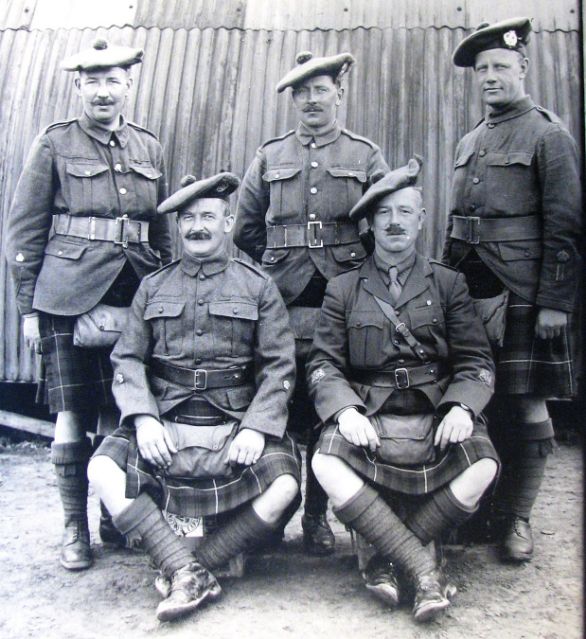Mud Waist Deep, Rain in Buckets, the Start of ‘Third Ypres’
Mud Waist Deep, Rain in Buckets, the Start of ‘Third Ypres’
Ian Riley, Liverpool Scottish Museum Trust
 The principle event of the late summer of 1917 was the opening of the Third Battle of Ypres in which the 55th (West Lancashire) Division played a leading but rain-soaked part and this article takes a brief look at their training, much more thorough than for the Somme in 1916, and action, influenced greatly by platoon commander and NCOs. Later in the campaign the 42nd (West Lancashire) Division, and two second-line Lancashire Divisions became involved, the 57th and the 66th. We hope to cover this in the next edition.
The principle event of the late summer of 1917 was the opening of the Third Battle of Ypres in which the 55th (West Lancashire) Division played a leading but rain-soaked part and this article takes a brief look at their training, much more thorough than for the Somme in 1916, and action, influenced greatly by platoon commander and NCOs. Later in the campaign the 42nd (West Lancashire) Division, and two second-line Lancashire Divisions became involved, the 57th and the 66th. We hope to cover this in the next edition.
KORLR: King’s Own (Royal Lancaster Regiment) KLR: King’s (Liverpool Regiment)
LF: Lancashire Fusiliers SLR: The South Lancashire Regiment
LNLR: Loyal North Lancashire Regiment.
1/4 KORLR is therefore 1/4th Battalion, King’s Own (Royal Lancaster Regiment) - 1000 men at full strength [1/4th is said as ‘First Fourth’].
55th Division had three infantry brigades, each of four battalions, 164, 165 and 166 Brigade
.jpg) The British Expeditionary Force [BEF] in France and Flanders [Belgium] devoted a huge amount of effort, following the Somme Campaign of 1916, in trying to improve individual field training and, at unit level, in improving tactics and operational procedures. An increasing proportion of its strength was now conscripted with limited training in the UK (about 14 to 16 weeks), The training infrastructure was developed both within units and in divisional and corps schools both in the UK and in theatre. Huge advances were made in the science of gunnery with improved planning, co-ordination and accuracy. The process of review had begun almost immediately during the Somme battles and by the spring of 1917, the focus of unit training was on the platoon rather than at the battalion or company level. The availability of the Lewis Gun (a ‘light’ machine gun issued at one per platoon by 1917 and, during 1918, on a scale of two per platoon) and the reorganisation of the infantry platoon into four specialist sections moved the responsibility of battlefield initiative to junior officers and senior NCOs. The Lewis Gun was carried by a single man but was part of a section of up to ten men for liaison and carrying ammunition. The account of the 1st/9th Bn of The King’s (Liverpool Regiment) [1/9 KLR], part of the 55th (West Lancashire) Division, written with the slightly cynical pen of a wearied Territorial soldier, records:
The British Expeditionary Force [BEF] in France and Flanders [Belgium] devoted a huge amount of effort, following the Somme Campaign of 1916, in trying to improve individual field training and, at unit level, in improving tactics and operational procedures. An increasing proportion of its strength was now conscripted with limited training in the UK (about 14 to 16 weeks), The training infrastructure was developed both within units and in divisional and corps schools both in the UK and in theatre. Huge advances were made in the science of gunnery with improved planning, co-ordination and accuracy. The process of review had begun almost immediately during the Somme battles and by the spring of 1917, the focus of unit training was on the platoon rather than at the battalion or company level. The availability of the Lewis Gun (a ‘light’ machine gun issued at one per platoon by 1917 and, during 1918, on a scale of two per platoon) and the reorganisation of the infantry platoon into four specialist sections moved the responsibility of battlefield initiative to junior officers and senior NCOs. The Lewis Gun was carried by a single man but was part of a section of up to ten men for liaison and carrying ammunition. The account of the 1st/9th Bn of The King’s (Liverpool Regiment) [1/9 KLR], part of the 55th (West Lancashire) Division, written with the slightly cynical pen of a wearied Territorial soldier, records:
About this time [Spring 1917] the platoons were reorganised in accordance with a training pamphlet that had lately been issued. Henceforth they were to consist of a Lewis gun section, a section of bombers, another of rifle grenadiers, and a fourth of rifle-men, and the men were taught the new formation to be adopted for the attack which was known as the "Normal Formation," one consisting of lines and waves of attackers. [Roberts, The Story of the 9th King’s In France].
The ‘training pamphlet’ referred to, rather languidly, was SS 143 Instructions for Training of Platoons for Offensive Action 1917, described by the well-known poet and author Robert Graves, in his book Goodbye To All That, as ‘perhaps the most important War Office publication issued during the war’, an opinion based on his experience as a front-line junior officer with the Royal Welch Fusiliers and, after being badly wounded on the Somme, as an instructor with an officer cadet training battalion. It became the platoon commander’s bible: the platoon commander (and his NCOs) became the principal instructors of their own platoons.
To the right are Warrant Officers of the Liverpool Scottish (1/10KLR) at Poperinghe, 7 miles to the rear of Ypres (Ieper) 1917. Back (l to r) CSM MacDonald (a volunteer since 1903, KIA September 1917), CSM Amos (to win the Distinguished Conduct Medal when he took command of his company, all officers being casualties), CSM Marples (two wound stripes on his sleeve and to win the Military Cross securing the left flank of the Division). Front (l to r) RQMS Stoddart (sitting on a box marked 'Government Explosives', a volunteer since before 1901, died of wounds August 1917), RSM Jennings (originally permanent staff with 18 years service with the Gordon Highlanders) (Liverpool Scottish Museum Trust).
The changes in platoon organization and the ‘normal’ form of the attack (actually the subject of a separate publication) had come about through liaison with the French and through development at one of the Third Army Training School in France. The key decision to place a Lewis Gun with each platoon rather than concentrate them within the battalion had been made by Field Marshal Sir Douglas Haig in February 1917. Doctrine was regularly updated throughout the war by formal publication and, doubtless, by some informal adaptation within units.
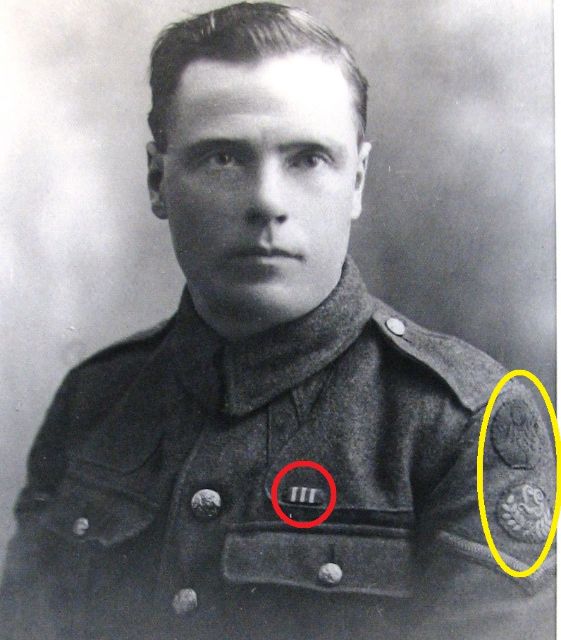 The Lewis Gun was carried by a single man but it was served by a section of nearly ten men (most armed with rifles) to carry ammunition and control fire It weighed 28 lb (13 kg), had magazines holding 47 rounds and an effective range of 880 yards (approx. 800 m) with a rate of fire of 500/600 rounds per minute. This, and the other specialised sections of the infantry platoon, gave its commander much more flexibility and allowed the platoon to tackle enemy pillboxes and other emplacements.
The Lewis Gun was carried by a single man but it was served by a section of nearly ten men (most armed with rifles) to carry ammunition and control fire It weighed 28 lb (13 kg), had magazines holding 47 rounds and an effective range of 880 yards (approx. 800 m) with a rate of fire of 500/600 rounds per minute. This, and the other specialised sections of the infantry platoon, gave its commander much more flexibility and allowed the platoon to tackle enemy pillboxes and other emplacements.
The photo to the left shows a Lance-Corporal of the 55th (West Lancashire) Division, his divisional 'Red Rose' insignia (so after the middle of 1917) and his 'Lewis Gunner' specialist badge in the yellow oval and the ribbon of the Military Medal in the red circle. It did much to make the infantry platoon independent of other support (Liverpool Scottish Museum Trust).
In the joint spring offensive of 1917 with the French, our allies met with large losses and almost complete failure. Subsequently there were mutinies that paralyzed the French Army. This left France unable to contribute on an equal basis with the BEF in the summer and autumn. The plan for the summer was for an attack launched eastward from the Ypres (Ieper) area to drive through the German defences (comprising of six lines nearly 10 km deep) towards the strategic rail centre of Roulers [Roeselare] and if possible towards the Channel ports from where German U Boats, seriously threatening the UK’s food supply, operated. It was planned to be in conjunction with a landing on the Channel coast (‘Operation Hush’) near Nieuwport, 25 miles north but a pre-emptive German attack along the coast in July meant that ‘Hush’ was cancelled.
The 55th Division trained for the summer attack in rear areas, withdrawn from the forward areas brigade by brigade for two or three periods, each of several weeks, complete with their own supporting artillery, engineers and medical cover. McGilchrist in his history of the Liverpool Scottish (1/10 KLR) speaks for all units of the 55th Division:
The ground allotted to the Division for the assault was the sector it knew so well in front of Wieltje and Potijze, and there was ample time in which to teach every man the main outline of the attack as a whole and his own particular place in it. To simplify the training [in the rear area] and to add realism to it, the first work undertaken was to map out with the aid of aeroplane photographs a facsimile not only of the enemy's front‑line system of trenches with all its saps, strong‑points, known machine‑gun emplacements, etc., but of his defences farther back - trenches, fortified buildings and gun‑positions. The stretch of country on which this full‑scale plan was laid out was chosen as far as possible for its resemblance to the actual ground over which the attack would take place, and on it the Royal Engineers marked out with tapes the positions and outlines of the German defences. [McGilchrist]
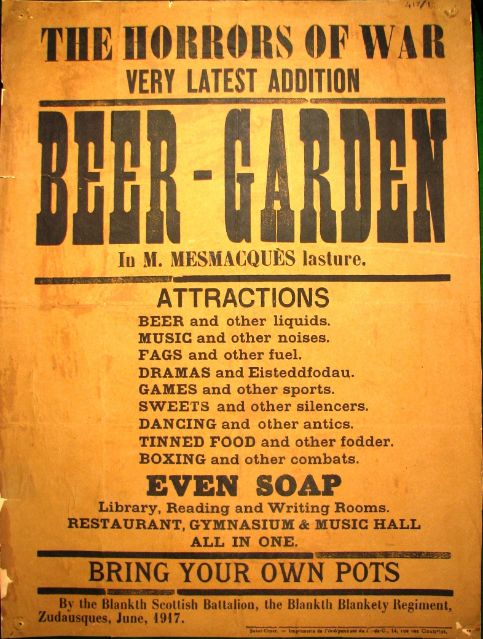 In the middle of digging the actual trenches, entertainment for the battalion was provided through the efforts of CQMS RA Scott Macfie (with financial support from his CO and the MO, Captain Noel Chavasse) in a highly successful ‘Beer Garden’, described as ‘Library, Reading, and Writing rooms, Restaurant, Gymnasium and Music Hall all in one’ and where Macfie proposed to hold a rather less-than Welsh ‘Eisteddfod’. Macfie was a man who provided what he promised and the Beer Garden ran for some time in the rear area.
In the middle of digging the actual trenches, entertainment for the battalion was provided through the efforts of CQMS RA Scott Macfie (with financial support from his CO and the MO, Captain Noel Chavasse) in a highly successful ‘Beer Garden’, described as ‘Library, Reading, and Writing rooms, Restaurant, Gymnasium and Music Hall all in one’ and where Macfie proposed to hold a rather less-than Welsh ‘Eisteddfod’. Macfie was a man who provided what he promised and the Beer Garden ran for some time in the rear area.
The site chosen for the Beer‑Garden was in a little wood. A huge marquee ‑ the library, etc., advertised above was erected on a grassy slope, and before it, in the middle of a clearing, was a concert‑platform-boxing‑ring with the piano beside it. For a dressing‑room the artistes had to be content with a wigwam arrangement of draperies attached to the back of the piano.[McGilchrist]
The 1/9 KLR account of training seems rather less enthusiastic:
At the beginning of July the Battalion went to Moringhem to prepare for the great battle. This was a very small hamlet, and there must have been a great concentration of troops in the Pas de Calais, as this little place had to accommodate two battalions. The men were placed under canvas, and some of the officers lived in tents, while the remainder were accommodated in billets. The training was mainly devoted to the attack. The British and the enemy trenches were taped out on some cornfields, in propinquity to the hamlet, and the forthcoming attack was rehearsed time and time again by all the battalions in the Brigade. Great attention was paid to synchronisation of watches, and the immediate reporting of all information. Maps and aeroplane photographs of the ground were studied with meticulous care, and a model of the Battalion's sector over which it was to attack, showing Uhlan Farm, Jasper and Plum Farms, Pommern Castle, and Pommern Redoubt, was constructed outside the camp to explain the lie of the ground to the men. Tanks were represented by half limbers during these practices, and the shrapnel barrage by drums [Roberts].
More enthusiastic was the Liverpool Scottish viewpoint:
On 4 July the Brigadier held a conference of officers, and afterwards the Battalion - in co‑operation with the Brigade Machine‑Gun Company and Trench‑Mortar Battery - practised the attack over the prepared trenches. Each platoon was taken slowly over the ground representing its position in the attack and all points were explained to the men by their platoon commanders. Training on these lines continued for two days and the fact that platoon‑commanders were allowed to work out their own problems with their men and to see that each man thoroughly understood the details of the scheme from A to Z contributed in no small measure to the success of the operation when the time came to put theory into practice.
On 7 July a full‑dress rehearsal was carried out by the whole Brigade with the co‑operation of contact aeroplanes and tanks - of which two were attached to each battalion in the second phase. The barrage was represented by drums and Vérey lights Two further rehearsals were held, for the second of which, to approximate as nearly as possible to actual conditions, the Brigade paraded at night and attacked at dawn. Truly if any hitch were to occur in the battle itself it would not be for lack of forethought or training beforehand. [McGilchrist]
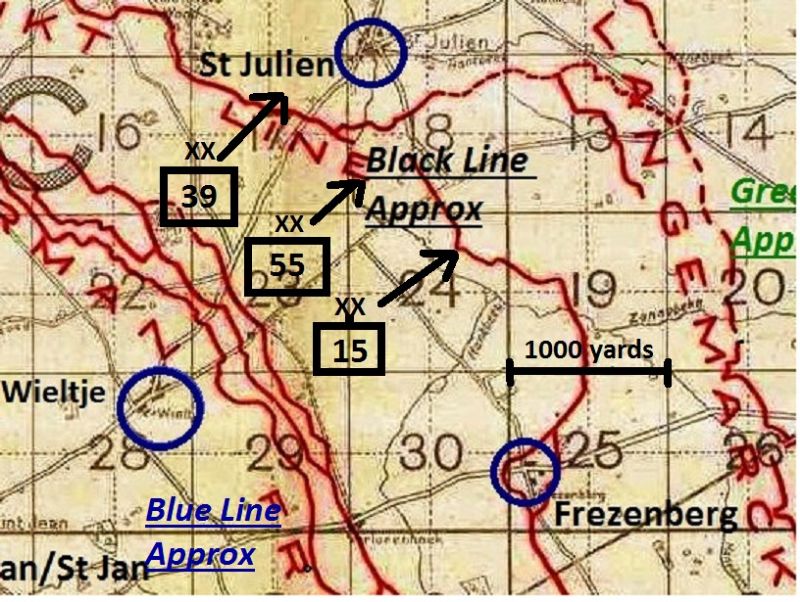 The major offensive in the Ypres area was known as the Third Battle of Ypres and lasted from the end of July to the end of November. Although often (wrongly) called the ‘Battle of Passchendaele’, it actually consisted of ten named ‘battles’ (only two of which are named after the village of Passchendaele) and a series of ‘actions’. The opening engagement was the Battle of Pilckem Ridge, 31 July to 2 August 1917. All were part of a plan to capture the heights of the Passchendaele Ridge that partially circles and dominates Ypres. The stage was set in early June by the Battle of Messines, the highly successful capture of the Messines Ridge south of Ypres, by Second Army following the explosion of nearly 20 mines below the ridge. It took, however, six weeks to relocate the artillery and to get troops and stores into position as well as complete the training and rehearsals and establish the command, signalling, engineering and supply infrastructures for the next battle.
The major offensive in the Ypres area was known as the Third Battle of Ypres and lasted from the end of July to the end of November. Although often (wrongly) called the ‘Battle of Passchendaele’, it actually consisted of ten named ‘battles’ (only two of which are named after the village of Passchendaele) and a series of ‘actions’. The opening engagement was the Battle of Pilckem Ridge, 31 July to 2 August 1917. All were part of a plan to capture the heights of the Passchendaele Ridge that partially circles and dominates Ypres. The stage was set in early June by the Battle of Messines, the highly successful capture of the Messines Ridge south of Ypres, by Second Army following the explosion of nearly 20 mines below the ridge. It took, however, six weeks to relocate the artillery and to get troops and stores into position as well as complete the training and rehearsals and establish the command, signalling, engineering and supply infrastructures for the next battle.
The 55th Division assaulted on the first day, 31 July, with two brigades (165 and 166) attacking first, the leading two battalions of each brigade advanced 1000 yards to take the first objective (known as the Blue Line – essentially just beyond the triple-trench system that up the German front line) and then the other two battalions of each brigade passed through to capture the second objective, the Black Line, which was the German second-line a further 1000 yards on, known as the Stutzpunkt line. The Blue Line was quite easily captured but fighting for the Black Line was much more intense with flexible tactics from the Germans prepared to leave prepared bunkers and set up machine gun posts in shell-holes that were much more difficult to spot.
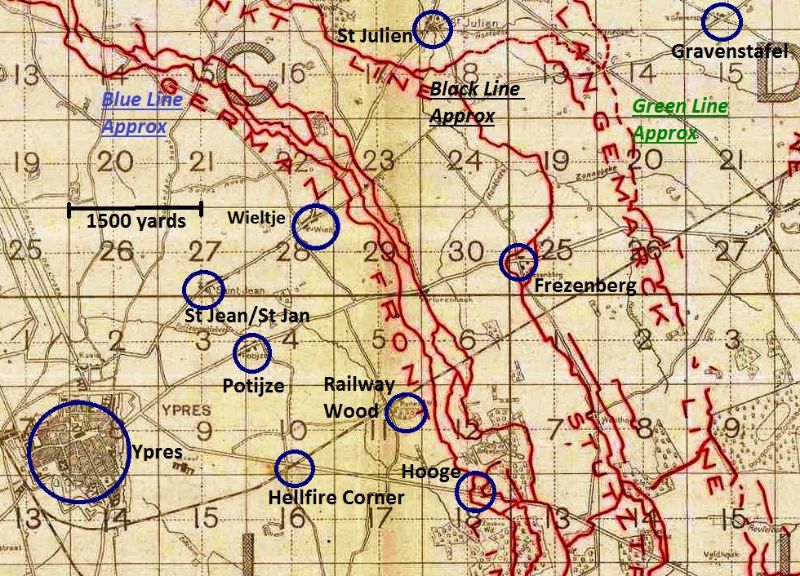 In the right hand brigade (165), the 1/5th KLR on the right flank of the Division was heavily engaged by three machine guns from a feature called Plum Farm and was forced to capture it despite it being forward of their own objective and still being shelled by ‘friendly’ artillery’ as they took it. As the second wave of battalions passed through to the Black Line, again the right hand battalion, 1/7 KLR, was engaged from a feature called Square Farm and which they were obliged to capture (evicting 130 Germans) despite it being in the area of the neighbouring division whose responsibility it was. Having achieved the Black Line objective, they were in touch with 166 Brigade to the left but not with the 15th Division on the right and so were exposed on that flank. 1/9 KLR had failed to maintain direction and moved across to their left and into the 166 Brigade area.
In the right hand brigade (165), the 1/5th KLR on the right flank of the Division was heavily engaged by three machine guns from a feature called Plum Farm and was forced to capture it despite it being forward of their own objective and still being shelled by ‘friendly’ artillery’ as they took it. As the second wave of battalions passed through to the Black Line, again the right hand battalion, 1/7 KLR, was engaged from a feature called Square Farm and which they were obliged to capture (evicting 130 Germans) despite it being in the area of the neighbouring division whose responsibility it was. Having achieved the Black Line objective, they were in touch with 166 Brigade to the left but not with the 15th Division on the right and so were exposed on that flank. 1/9 KLR had failed to maintain direction and moved across to their left and into the 166 Brigade area.
In the left-hand brigade (166), progress to the Blue Line by 1/5 KORLR and 1/5 LNLR was good but progress to the Black Line by 1/5 SLR and 1/10 KLR was much more difficult, the Liverpool Scottish having difficulty establishing contact with the 39th Division to the left of the 55th Division and so having an exposed flank. Platoons losing direction even over 1000 yards became a serious problem with the mixing of companies and battalions. Some companies were already very weak; V Company of 1/10 KLR had crossed the start line with strength of 4 officers and 44 ORs as a result of shelling and gassing before the battle.
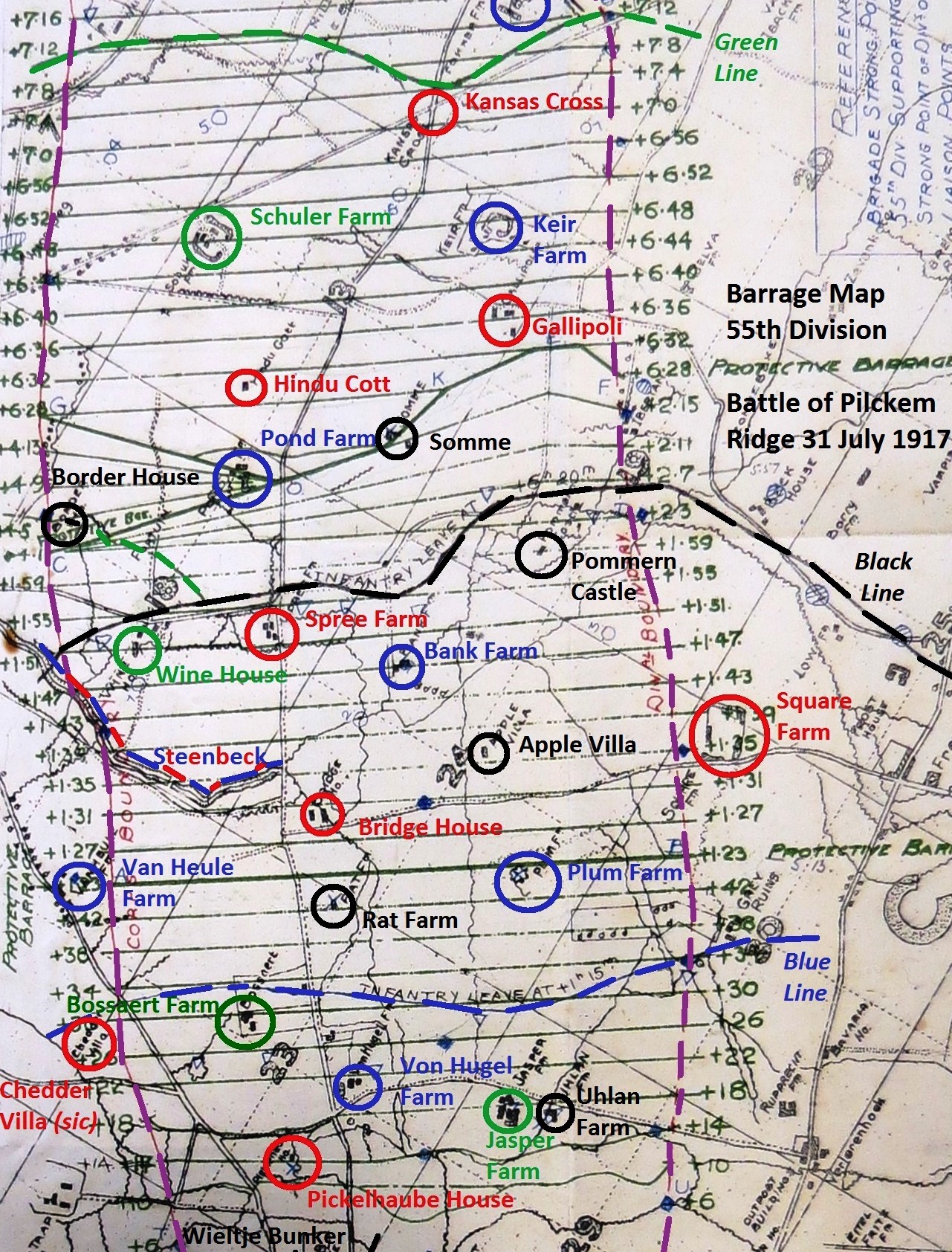 As part of his appraisal of divisional performance and to draw lessons from the action, the divisional commander, Major-General Hugh Jeudwine, asked for reports from the senior surviving available soldier of each infantry platoon. They are mostly still available and make interesting reading, in some cases written by Lance-Corporals or even private soldiers. A corporal of Z Company of 1/10 KLR wrote for the personal attention of Jeudwine, thirteen ranks his senior:
As part of his appraisal of divisional performance and to draw lessons from the action, the divisional commander, Major-General Hugh Jeudwine, asked for reports from the senior surviving available soldier of each infantry platoon. They are mostly still available and make interesting reading, in some cases written by Lance-Corporals or even private soldiers. A corporal of Z Company of 1/10 KLR wrote for the personal attention of Jeudwine, thirteen ranks his senior:
"3‑50 a.m. Barrage opened. All section in fine spirits. Gave strict instructions to same to pay strict attention to orders. 3‑51 a.m. Mount parapet and follow closely on L.N.L. The whole platoon kept excellent line until making L.R.B. Cottage. Was still then in direct touch with platoon officer who gave orders to settle down until further orders. 3‑56 a.m. Order from platoon officer to move forward. Section still well in good command. Passed over front system. Was in touch with platoon officer (now lost as regards time). Clear of front system but think I am going too much to the right. Come across enemy sniper in shell‑hole shamming death, with full equipment and rifle. Put sniper out and also find another and shoot the same . . . a lot of casualties occurring from machine‑gun on right. Marked spot and get into action with rifle‑grenades … Came up to platoon officer. Same gave me right direction and gave me orders to try my hand with resisting machine‑gun. Call my squad together - still intact. Get into ditch and make for machine‑gun. Arrive at machine‑gun, still under cover in ditch. Machine‑gun still firing overhead. Arrive at machine‑gun house minus squad. Was preparing to bomb machine‑gun when South Lancs. Bomber arriving simultaneously put him out (how tiresome). Asked had he cleared dugouts. No. Was then joined by ‘Y’ Company bomber. Together we cleared two dugouts, 15 Bosches getting away from dugout in rear. Fire on same, dropping 7 or 8 between us... Company then steadily going forward. . . Get two prisoners out of near dugouts of Farm. Dressed wounded prisoner and South Lancs. man. Carry on to join Company. Came up with Company about 50 yards our side of Steenbeek. Carry on then in short rushes to objective. . . . My section then intact. Platoon officer casualty. Get into Capricorn Trench. Asked C.S.M. if anybody has got in touch on left. No. Collect bombing squad and work to left. Then in direct touch with South Lancs. on right. Work about 100 yards to left. Further progress impossible. Trench bashed in so far. Come back and report all clear but nobody in touch. Then go up right hand C.T. with squad. Reach Capricorn Support, thus making all objectives gained. . . . Arrange with South Lancs. officer for squad to work along road and meet me on left. Send down to Capricorn Trench for Lewis‑gun. Get same into position and report back to Mr. Mackay. Front all clear. Enemy still holding Capricorn Keep. . . Come in with Mr. Gallop fixing post at junction of Capricorn Support and C.T. Good posts established by officers along whole line. Get in touch with `Y' Company on left. Enemy reported to be holding Support Line to right. Collect squad again and work up same, Mr. Mackay accompanying same. . . . No enemy in Capricorn Support. Salve two Lewis‑guns from Capricorn Support and made block and left sentries. . . ." [McGilchrist]
When the Black Line was secured, a planned six hours into the battle, the Division’s third brigade, 164, was to pass through the new front line to move to the third objective, the Green Line (the German Langemarck-Gheluvelt Line). The battalions of 164 Brigade, thinly spread on a wide frontage, suffered badly from shelling and machine gun fire when moving up. Matters were not helped when they were forced to fight to capture Spree Farm, a feature in the Black Line near the junction of the two leading brigades. This farm was understood to have been already secured. It was presumably here that the 26 year-old Lieutenant-Colonel Bertram Best-Dunkley, commanding 2/5 LF, personally led two of his Fusilier platoons forward to resolve the issue. For this and other actions during 31 July, he was awarded the Victoria Cross, posthumously as he died of wounds received in the battle. The citation for his VC reads:
Lieutenant-Colonel Bertram Best-Dunkley: For most conspicuous bravery and devotion to duty when in command of his battalion, the leading waves of which, during an attack, became disorganised by reason of rifle and machine gun fire at close range from positions which were believed to be in our hands. Lt.-Col. Best-Dunkley dashed forward, rallied his leading waves, and personally led them to the assault of these positions, which, despite heavy losses, were carried. He continued to lead his battalion until all their objectives had been gained. Had it not been for this officer's gallant and determined action it is doubtful if the left of the brigade would have reached its objectives. Later in the day, when our position was threatened, he collected his battalion headquarters, led them to the attack, and beat off the advancing enemy. This gallant officer has since died of wounds.
Another Territorial to win the VC on the first day, also with 164 Brigade, was Lance-Sergeant Thomas Mayson, of 1/4 KORLR, who single-handedly accounted for two machine gun posts. Also Captain Noel Chavasse VC MC, the medical officer of 1/10 KLR won a bar to the VC that he won a year previously. An account of his actions can be found on this site here. He too died of his wounds shortly after the battle.
The battle became a platoon commander’s battle. Part of the advance of 164 Brigade from the Black Line to the Green Line (once Spree Farm had been dealt with) is described in which German artillery batteries are captured by a series of platoon attack:
The advance from the Black Line was carried out according to programme. The artillery barrage was excellent and could be followed up closely, though it proved to be insufficiently dense to prevent enemy machine guns from firing through it. The 1/4th North Lancs. [1/4 LNLR], supported by the 1/4th Royal Lancasters [1/4 KORLR], successfully advanced to the Green Line, which they captured, commenced to consolidate, and established a line of outposts as laid down in the plan. In the course of this advance they captured five batteries of 77 m.m. guns, each of which had to be taken by a platoon attack. These batteries continued to fire until the last possible moment ‑ when our troops were within 100 yards of them.[Coop]
In Best-Dunkley’s Fusilier battalion, 2/5 LF, one of its companies reached the Green Line with one officer (Captain Bodington) and ten men, soon to be reduced to one officer and two men. Patrols reached the Green Line and beyond but exposed and out of touch on either flank and suffering crushing counter-attacks from the fresh enemy troops on either side, 164 Brigade was driven back with severe casualties, virtually to the Black Line which had in any case to be reinforced by battalions sent forward from the Blue Line. The withdrawal was covered by determined resistance but from a post manned by Captain Bodington who had collected some 130 men, only ten appear to have made it back to the Black Line where, in the absence of any officers at all (until Bodington came in), the defence of battalion headquarters was organised by the Orderly Room Sergeant. Here the line stayed until the 55th Division was relieved during the night of 2/3 August. The 164 Brigade would probably have started the battle about with about 80 officers and 2000 rifles in the attack: by the end of 1 August, Major-General Jeudwine reported to his Corps Commander that they had 11 officers and about 500 rifles and that his other two brigades were severely understrength and exhausted to the point that he was uncertain whether they might be able to withstand a further attack and would certainly not be able to go into the attack again.
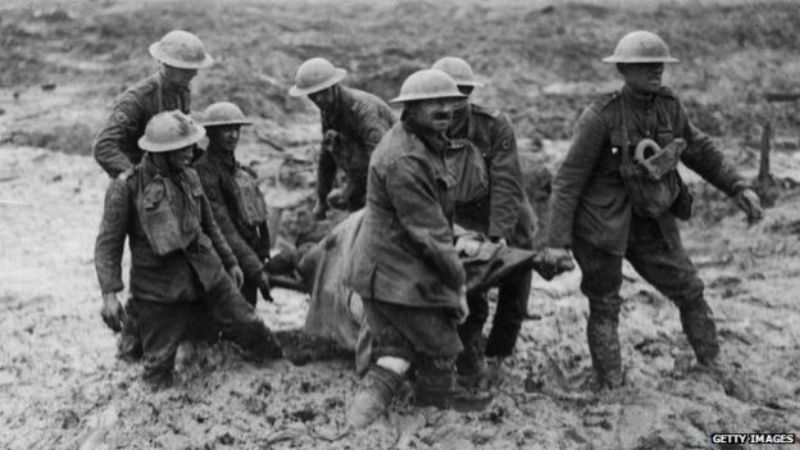 On the left flank of the Division, in the 1/10 KLR, CSM David Marples was with ‘X’ Company. When the 39th Division had failed to come up alongside he has secured the left flank both of his battalion and of the 55th Division with a distinction that earned him the Military Cross, one of few awarded to a warrant officer. By evening of 31 July he was assisting his third company commander of the day. He witnessed not only the withdrawal of 164 Brigade but also the effects of the incessant rain that turned the battlefield, pitted with shell-holes and with any semblance of drainage destroyed, into an expanse of knee and waist-deep mud, the like of which none had experienced before, mud that required eight-man teams to carry a stretcher:
On the left flank of the Division, in the 1/10 KLR, CSM David Marples was with ‘X’ Company. When the 39th Division had failed to come up alongside he has secured the left flank both of his battalion and of the 55th Division with a distinction that earned him the Military Cross, one of few awarded to a warrant officer. By evening of 31 July he was assisting his third company commander of the day. He witnessed not only the withdrawal of 164 Brigade but also the effects of the incessant rain that turned the battlefield, pitted with shell-holes and with any semblance of drainage destroyed, into an expanse of knee and waist-deep mud, the like of which none had experienced before, mud that required eight-man teams to carry a stretcher:
Rain fell during the night [31 July/1 August] and by morning, it was evident that our trench on the Dotted Green Line would soon become untenable owing to the depth of water and mud rapidly accumulating. At dawn on Aug[ust] 1st there were signs that the enemy had been flooded out also and had retired from his newly dug position and was not visible all day except in very small parties which were scattered by our Lewis Guns. On the night of Aug 1st at dusk, the trench was no longer tenable, entirely owing to the weather and, on the COs orders, X and Y Coys withdrew about 100 yards to CANVAS TRENCH.
This trench was now organised for defence and strongly held by 1 MG and 4 L Guns and about 60 rifles. Work was carried out during the night on consolidating, and rain fell heavily all day. Enemy was quiet during the day, but on our left in response to an SOS the Coy stood to about 6 pm, during a heavy artillery duel. The Coy was relieved … on the night of Aug 2/3rd [Liverpool Scottish Museum Trust]
In spite of the casualties, the accounts of soldiers indicate that that the preparation in training had paid off and Major-General Jeudwine’s insistence that every man should know his role and that of his unit yielded dividends when officers and senior NCOs became casualties. The historian of the 1/10 KLR (a serving officer of the Liverpool Scottish) wrote:
The success of the attack demonstrated very clearly the value of the preliminary training which had been carried out at Esquerdes. Every man had in his head a mental picture of the ground over which he would advance and of the position of the objective of his own particular platoon and company. This familiarity on the part of all ranks with every detail of the attack was one of the principal factors in its successful issue. The enemy as he was forced back from each successive position deliberately left snipers behind him in shell‑holes and hedges - and stout fellows they must have been. "X" Company combed two of them out of a tree with a Lewis‑gun. Their duty was to pick off leaders. As a result the casualties amongst officers and senior N.C.O.'s were severe, and by the time the objective was reached several corporals and lance‑corporals - in one case even a private - found themselves in command of platoons. If these men had not had an accurate idea of exactly what was required of them confusion and failure must have resulted. They all rose magnificently to the occasion and took charge of their men like seasoned commanders. [McGilchrist]
The judgement was that the 55th Division had done well but had not been able to hold the furthest objective because of open flanks.
Further Reading:
E.H.G. Robert: The Story of the 9th King’s In France
A.M. McGilchrist: The Liverpool Scottish 1900-1919
The Rev J.O. Coop: The Story of the 55th (West Lancashire) Division
K. Shannon: The Lion and the Rose, Volumes 1 and 2 (recently published -1/4 KORLR and 1/5 KORLR)
Jeudwine Papers;Liverpool Record Office 356 FIF 2/1 and 2/2 [Appointment necessary]
SS 143 Instructions for Training of Platoons for Offensive Action1917
Previous page: Territorials Battle Desert Heat and Germany’s Air Aces.
Next page: Territorials Uphill Fight Toward Passchendaele
